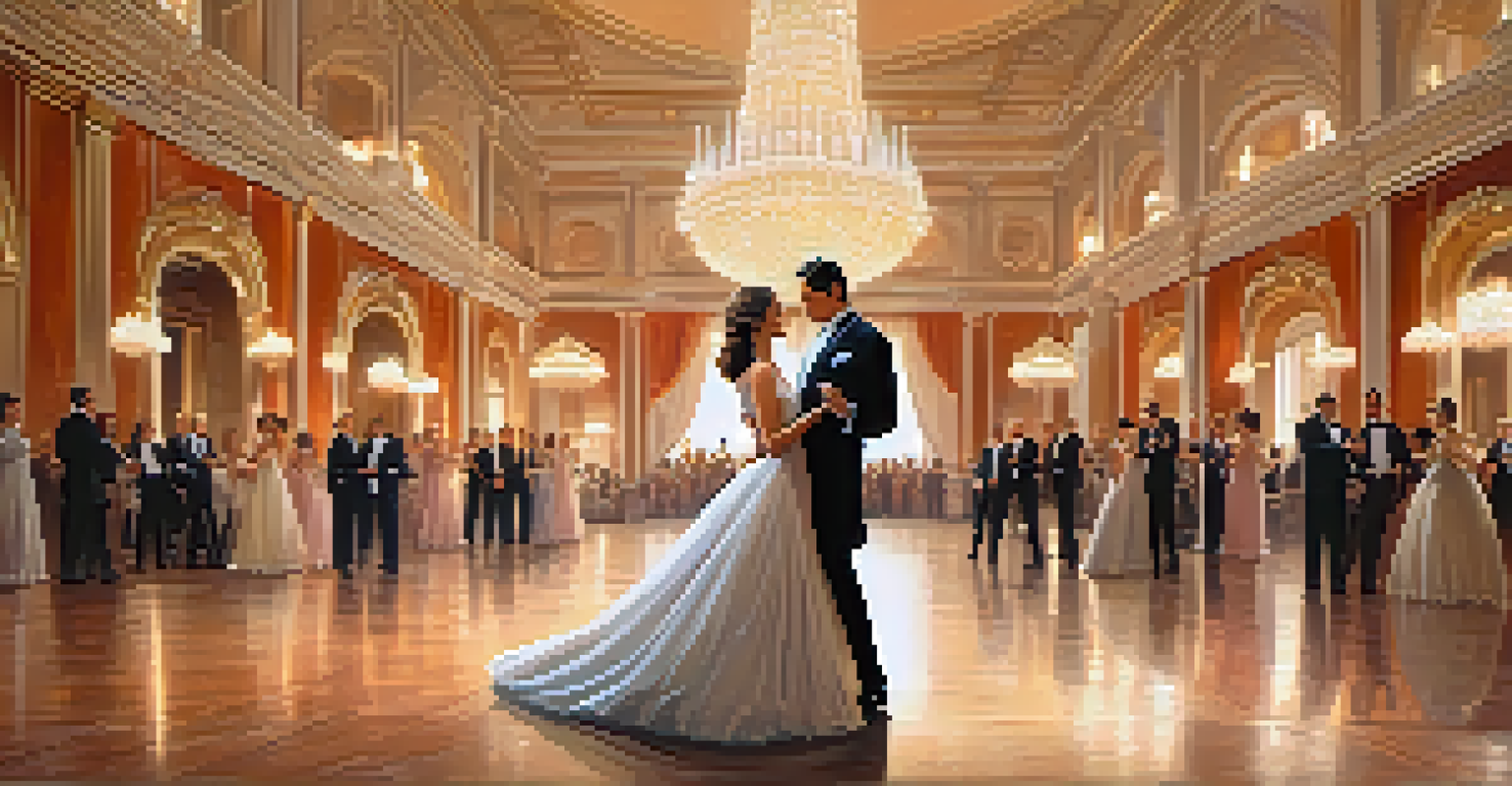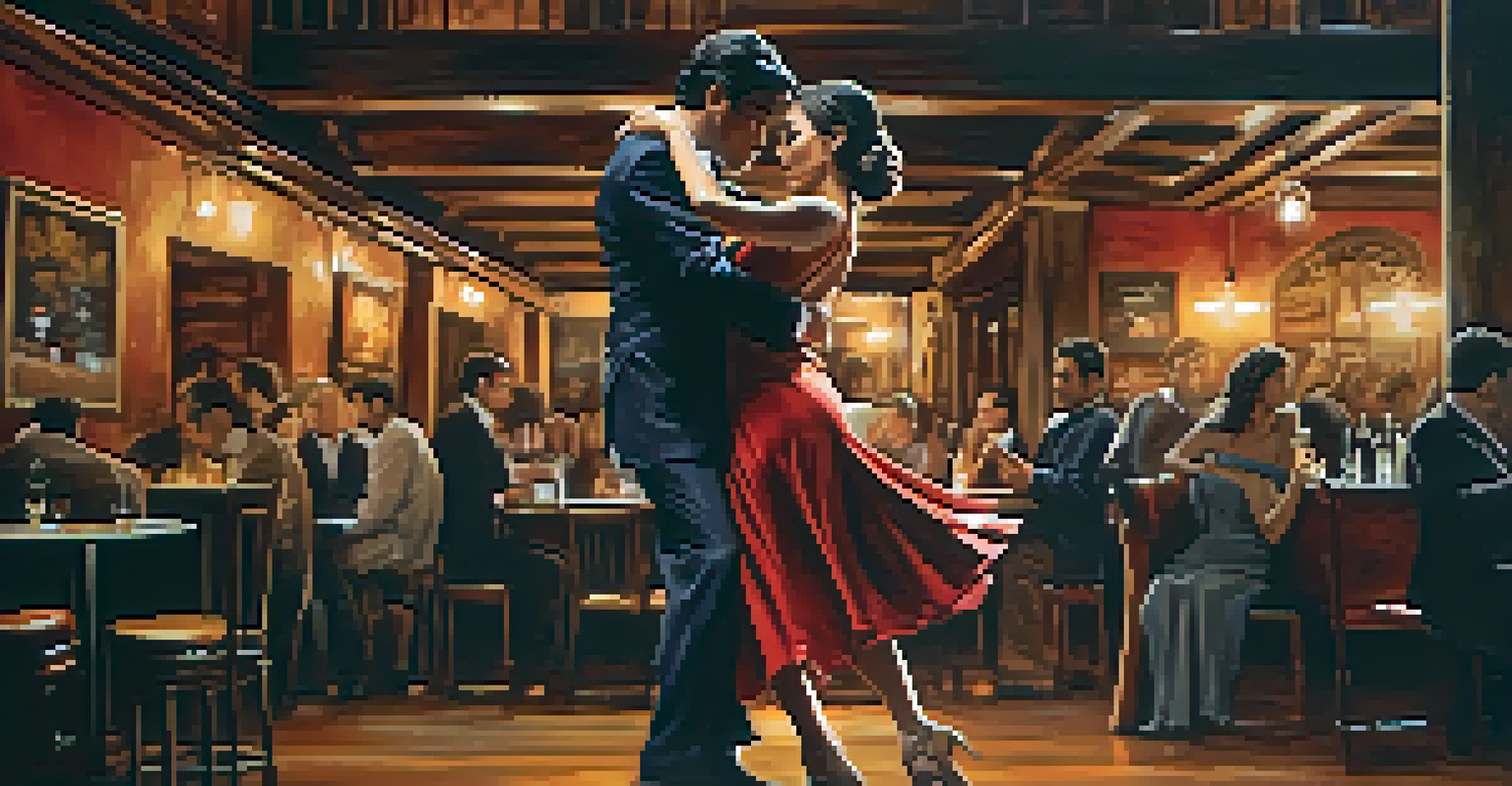Social Dance Styles: A Journey Through Global Traditions

The Joy of Social Dance: A Universal Language
Social dance serves as a powerful form of expression, transcending language barriers. It brings people together, fostering connections that are often hard to put into words. From the rhythmic beats of salsa to the graceful movements of waltz, each dance style tells a story of culture and community.
Dance is the hidden language of the soul.
Imagine walking into a room filled with people, all moving in sync to the music. You may not share a common language, but through the dance, you feel an immediate bond. This is the beauty of social dance—it creates a shared experience that is both intimate and exhilarating.
As we journey through various social dance styles, we'll discover how each one reflects the values, history, and spirit of its culture. So, let’s lace up our dancing shoes and explore the captivating world of social dance!
Salsa: A Lively Celebration of Latin Heritage
Salsa originated in the Caribbean, particularly Cuba and Puerto Rico, blending African rhythms with Spanish melodies. It’s not just a dance; it’s a vibrant celebration of life, often performed at parties and social gatherings. The energetic movements and lively music create an atmosphere that’s hard to resist.

Picture yourself in a brightly lit salsa club, with the sound of horns and drums filling the air. Couples twirl and spin, their smiles radiating joy. Salsa encourages improvisation, allowing dancers to express their individuality while still connecting with their partners.
Dance as a Universal Language
Social dance transcends language barriers, fostering connections and shared experiences among people from diverse backgrounds.
This dance style has evolved into numerous variations, each with its own flair, whether it’s LA-style salsa, Cuban salsa, or Colombian salsa. Salsa dances not only enhance physical fitness but also foster social interaction, making it a beloved global pastime.
The Elegance of Waltz: A Dance of Romance
Waltz, known for its graceful and flowing movements, originates from 18th-century Europe. This dance is often associated with formal events, embodying elegance and romance. The distinctive 3/4 timing creates a gentle sway that feels almost like floating across the dance floor.
Dancing is like dreaming with your feet!
Imagine a couple gliding together in a grand ballroom, their movements synchronized to the enchanting music. The waltz is not just about the steps; it’s about the connection between partners, sharing the beauty of the moment. It teaches dancers how to lead and follow, fostering trust and communication.
Throughout history, the waltz has evolved, giving rise to various styles like Viennese and American waltz. Each variation brings its own uniqueness, but the core essence of romance and connection remains unchanged, making it a timeless favorite.
Tango: The Passionate Dance of Argentina
Tango, with its sultry movements and dramatic flair, hails from the streets of Buenos Aires, Argentina. This dance is steeped in history, born from the fusion of various cultural influences, including African, European, and indigenous traditions. Tango is more than just a dance; it’s a passionate expression of longing and connection.
Visualize a dimly lit tango bar, where couples embrace tightly, moving in perfect harmony. The intensity of the music mirrors the closeness of the dancers, creating an atmosphere charged with emotion. Tango emphasizes the connection between partners, often requiring deep understanding and subtle communication.
Cultural Reflection in Dance Styles
Each social dance style, from salsa to Bharatanatyam, reflects the values, history, and spirit of its culture, showcasing the diversity of human experience.
As tango spread globally, it adapted and evolved, leading to diverse styles like Ballroom tango and Nuevo tango. Each variation showcases the beauty of this dance while preserving its core essence of passion and connection.
Hip Hop: The Pulse of Urban Culture
Hip hop dance emerged from the vibrant streets of New York City in the 1970s, reflecting the energy and creativity of urban culture. This dynamic style encompasses various forms, including breakdancing, locking, and popping. Hip hop is more than just a dance; it’s a movement, a way to express individuality and address social issues.
Imagine a lively street corner, where dancers showcase their skills, drawing a crowd of onlookers. The rhythm of the music drives the dancers, who often incorporate personal flair into their routines. Hip hop allows for creativity and improvisation, making each performance unique.
As hip hop has gained popularity worldwide, it has influenced countless other dance styles. From dance battles to competitions, hip hop continues to evolve, proving that it is a powerful form of self-expression that resonates with people across cultures.
Bharatanatyam: The Storytelling Dance of India
Bharatanatyam is one of the oldest classical dance forms in India, known for its intricate footwork and expressive gestures. This dance style originated in the temples of Tamil Nadu and has deep roots in Indian culture and spirituality. Each movement tells a story, often depicting religious themes and folklore.
Picture a dancer adorned in traditional attire, gracefully moving to the rhythm of the accompanying music. The use of facial expressions, hand gestures, and body movements creates a vivid narrative that captivates the audience. Bharatanatyam is a beautiful blend of storytelling and artistry.
Building Community Through Dance
Engaging in social dance enriches lives by promoting creativity, relationships, and a sense of belonging within communities.
In recent years, Bharatanatyam has gained international recognition, inspiring dancers around the world. It serves as a reminder of the rich cultural heritage of India, inviting everyone to appreciate the beauty of this unique dance form.
African Dance: A Celebration of Community and Tradition
African dance is as diverse as the continent itself, with each region offering unique styles that reflect cultural traditions. Dance plays a vital role in African communities, serving as a means of celebration, storytelling, and spiritual connection. These dances often incorporate elements of nature, rhythm, and communal participation.
Imagine a vibrant village gathering, where people come together to celebrate milestones through dance. The rhythm of drums fills the air, inviting everyone to join in. African dance emphasizes the collective experience, fostering a sense of belonging and unity among participants.

As African dance continues to evolve, it influences various global dance forms, enriching the world of dance with its vibrant energy and cultural significance. Embracing African dance offers an opportunity to appreciate its rich history and the joy it brings to communities.
Conclusion: The Unifying Power of Social Dance
As we wrap up our exploration of social dance styles, it’s clear that dance is a powerful tool for connection and expression. Each style we’ve examined offers a glimpse into the culture and history it represents, showcasing the diversity of human experience. From the lively salsa to the elegant waltz, social dance has a unique way of uniting people.
Whether you’re a seasoned dancer or a curious beginner, engaging with social dance can enrich your life. It encourages creativity, builds relationships, and promotes a sense of community. No matter where you are in the world, there’s likely a dance waiting for you to join in.
So, let’s celebrate the beauty of social dance—an art form that not only entertains but also deepens our understanding of one another. By embracing different dance styles, we open ourselves to the joys of cultural exchange and friendship.